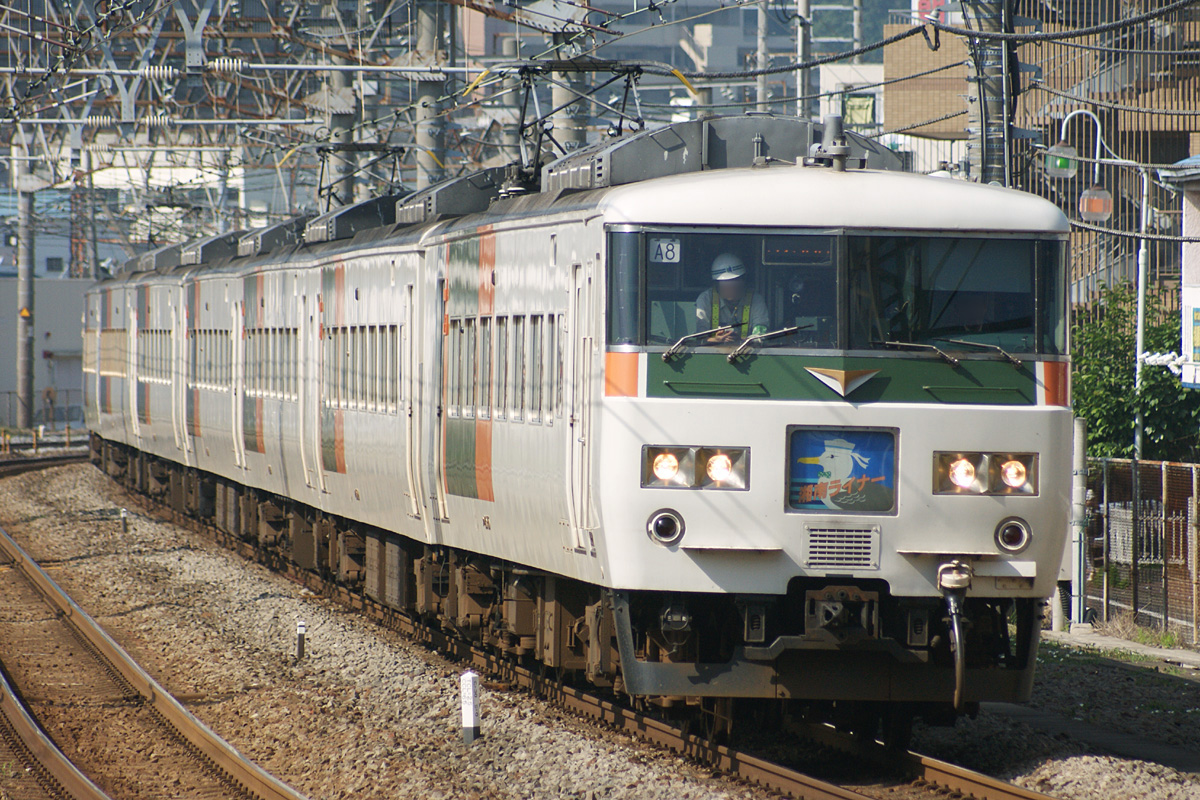- 185 series
imagesize = 240px
caption = A 185 series train on a "Shonan Liner" rapid service (July 2007)
InService = March 1981 - Present
Manufacturer =
Family =
Built = 227 cars
Refurbishment =
Formation = 5/7/10 cars per trainset
Operator =JR East
Depots = Ōmiya, Tamachi
LinesServed =
CarBody = Steel
CarLength = 20,280 mm (end cars), 20,000 mm (intermediate cars
CarWidth = 2,946 mm
CarHeight = 4,066 mm
MaxSpeed = 110 km/h
Weight =
Capacity =
Acceleration =
Deceleration =
Traction =
Power = 120 kW traction motors
Gauge = 1,067 mm
Voltage = 1,500 V DC overhead
Brakes =
SafetySystem = ATS-P, ATC, D-ATCThe 185 series is an EMU operated by
East Japan Railway Company (JR East) primarily on middle-distancelimited express services centering onTokyo .The class is broadly divided into two variants: 185-0 series for use south-west of Tokyo, and 185-200 series originally for use north of Tokyo.
185-0 series
The 185 series was primarily intended to replace ageing 153 series EMUs used on "Izu" express trains from Tokyo to the
Izu Peninsula . The requirement was also for a "general-purpose" train that could also be used occasionally on local services. This resulted in a design featuring 1,000 mm wide doors at either end of each car, compared with the standard limited express (e.g.183 series ) layout with 700 mm wide doors at one end of each car.A total of eight 10-car sets (sets A1 to A8, including two Green cars) and seven 5-car sets (sets C1 to C7) were built between 1979 and 1980 (115 vehicles in total), delivered to Tamachi depot. Initially, they were phased in on "Izu" express trains from March 1981, working alongside (and sometimes coupled with) the older 153 series trains. In October 1981, the "Izu" express was upgraded to become the "
Odoriko " limited express, with all trains formed of 185 series sets.In addition to the "Odoriko" services, sets are used on morning and evening "Liner" commuter services, including the "Shōnan Liner". Since the start of the October 1981 timetable, 185 series sets have also been used on the 521M local service from Tokyo (depart 07:24) to Izu (arrive 09:48).
Formations
10-car Tamachi sets A1 to A8
KuHa185 + MoHa185 + MoHa184 + MoHa185 + MoHa184 + SaRo185 + SaRo185 + MoHa185 + MoHa184 + KuHa185
5-car Tamachi sets C1 to C7
KuHa185 + MoHa185 + MoHa184 + SaHa185 + KuHa185
Refurbishment
Between 1993 and 1998, the original Japanese-style toilets in cars 1, 5, and 10 of the A sets, and cars 11 and 15 of the C sets were replaced with western-style toilets. In 1998, the Green car seats were upgraded. Then, from 1999 to 2002, all sets underwent refurbishment, which primarily involved replacing the original flip-over seating in standard-class cars with rotating/reclining seats to bring the level of accommodation in line with other limited express rolling stock. Externally, the sets were repainted from the original white livery with diagonal green stripes to white with "Shōnan" green and orange blocks.
185-200 series
Sixteen 7-car sets (112 vehicles) including one Green car were delivered between 1980 and 1981 to Shin-Maebashi depot to replace ageing 165 series EMUs. Compared with the earlier 185-0 series sets, these had cold-region specifications, including snow-resistant brakes, front-end horn covers, and were able to operate over the
Usui Pass between Yokokawa andKaruizawa in conjunction withJNR Class EF63 electric locomotives. Livery was white with a single green band running the length of each car below the windows. The first trains were introduced on express services such as the "Kusatsu" and "Karuizawa" from December 1981.Currently, the Ōmiya-based sets are used on "Kusatsu" (Ueno - Manza-Kazawaguchi), "Minakami" (Ueno - Minakami), and "Akagi" (Ueno - Maebashi) limited express services, as well as "Weekend Akagi" services. The Tamachi-based B sets are used on "Ohayō Tochigi" (Shinjuku - Kuroiso/Utsunomiya) and "Hometown Tochigi" (Shinjuku - Kuroiso) services as well as "Odoriko" and "Hamakaiji" limited express services.
Formations
7-car Ōmiya sets OM01 to OM09
KuHa185 + MoHa185 + MoHa184 + MoHa185 + MoHa184 + SaRo185 + KuHa185
7-car Tamachi sets B1 to B7
KuHa185 + MoHa185 + MoHa184 + SaRo185 + MoHa185 + MoHa184 + KuHa185
"Shinkansen Relay"
Between
23 June 1982 and March 1985, the 185-200 series trains were also used on special "Shinkansen Relay" shuttle services operating between Ueno in Tokyo and Ōmiya, the then southern terminus of the newly-openedTōhoku Shinkansen . These services ended in March 1985 when the shinkansen line was extended to Ueno. Four sets were then transferred to Tamachi depot for use on "Odoriko" services. These sets were reformed with the Green car moved from car 6 to car 4, and were repainted with diagonal green stripes to match the 185-0 series sets based at Tamachi depot. A further three sets were transferred to Tamachi between 1988 and 1991, becoming sets B1 to B7.Refurbishment
Between 1993 and 1998, the original Japanese-style toilets in cars 1, 4, and 7 of the Tamachi-based B sets were replaced with western-style toilets.
The nine sets remaining at Shin-Maebashi depot were all refurbished between September 1995 and November 1996. Refurbishment involved replacing the original flip-over seating in standard-class cars with rotating/reclining seats. Externally, the sets were repainted in white with yellow/grey/red blocks intended to depict the Jōmō mountain range together with "EXPRESS 185" markings below the windows.
In March 2006, the Shin-Maebashi-based sets were transferred to Ōmiya depot, becoming sets OM01 to OM09.
Between March and June 1996, three of the 7-car sets based at Tamachi (B3 to B5) were fitted with ATC equipment for use on the
Keihin-Tōhoku Line andNegishi Line when operating on "Hamakaiji" services. These sets were upgraded with D-ATC equipment between January 2006 and March 2007.References
* Takao Ōkuma, "185系電車の登場の背景とそのメカニズム", Tetsudō Daiya Jōhō magazine Vol.37 No. 2, February 2008, p.12-46
* JR全車輌ハンドブック2006, Neko PublishingExternal links
* [http://www.jreast.co.jp/train/express/185odoriko.html JR East 185 series Odoriko] (Japanese)
* [http://www.jreast.co.jp/train/express/185akagi.html JR East 185 series Akagi/Kusatsu/Minakami] (Japanese)
Wikimedia Foundation. 2010.

